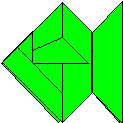| Origami Heaven A paperfolding paradise The website of writer and paperfolding designer David Mitchell
|
|||||||||||||
|
|||||||||||||
 |
|||||||||||||
| There
aren't any. Origami doesn't have rules, but it does have
ethics. Origami ethics are the design/folding standards within which individual paperfolding designers and paperfolders may (or may not) choose to work and ideals to which they may (or may not) aspire. The point of origami ethics is to preserve the degree of challenge that origami design and folding offers, just as, for instance, the point of rock-climbing ethics is to preserve the degree of challenge that climbing a rock-face offers. Origami ethics relate to such questions as
These questions may be (and often are) enthusiastically debated in terms both of the general nature of origami and of their specific effect on the design and folding processes. Whilst there is a broad general concensus among paperfolders on many issues, origami ethics remains essentially a matter of individual preference and choice. Just as an example of how origami ethics works let's think about cuts. The idea that origami designs shouldn't make use of cuts is a modern one, and in many ways largely a Western one (but one that has spread back to Japan). Cuts make it possible to isolate sections of the paper so that they can be folded separately from the rest, making it much easier to create designs with many arms, legs, wings etc. Many traditional Japanese designs, such as the Goldfish pictured above, use cuts for this purpose. However, many modern paperfolders think that this makes things too easy. If you want to design or fold a spider from a single sheet it is simple to do so if you are prepared to cut into the paper to create enough points for the legs, but much more difficult if you want to somehow find them all without using cuts. Many paperfolders and paperfolding designers feel that overcoming these kind of design and folding challenges is the point of what they do. Cutting is too easy an option and to be avoided at all costs. The result of this ethic is, of course, that paperfolding designers and folders have rapidly pushed out the boundaries of what is possible. Eight legged spiders are now regarded as hardly a challenge at all. However, folding complex designs without using cuts has its downside. The result of avoiding cuts is that designs end up many layers of paper thick and often look quite unattractive, not to say sometimes downright ugly. Left to its own devices, paper tends to unfold itself and the layers spread apart, which compounds the problem. Paperfolders sometimes therefore resort to soaking parts of their designs in glue to hold the layers together. Complex designs may also lack the strength to support their own weight, and need to be supported by wire frames. Some folders even conceal these frames from view within the folds so that you do not know they are there. So avoiding cuts has unexpected consequences which raise further ethical questions of their own. |
|||||||||||||